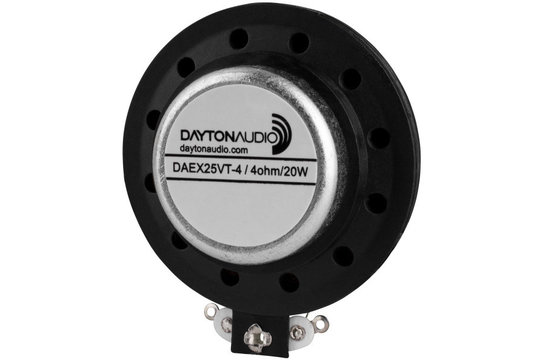





- We ship to United States of America
- Ordered now, shipped on Monday
- Five-year warranty
- 45-day cooling-off period to return
-
Customer rating:


















Take your product or project to the next level by turning it into a speaker! The DAEX25VT-4 is designed by Dayton Audio with voice coil cooling air vents, for high-power applications.
Dayton Audio DAEX25VT-4 Vented 25mm Exciter 20W 4 Ohm
Dayton Audio's 25 mm DAEX25CT-4 coin type exciter features the same ability to turn nearly any surface into a speaker, as other exciters and tactile transducers, only in a more compact package for working with smaller surfaces. This exciter's small size enables audio reproduction in places never imagined: toys, monitors, cabinet doors... even windows!
A neodymium magnet is employed to create maximum magnetic flux around the proprietary voice coil for increased sensitivity when compared to similar sized exciters. In turn, this reduces power requirements and makes it possible to use very small audio amplifiers, without sacrificing total output. The 1" voice coil, and cooling vents, allows for more input power for higher output applications while maintaining a slim-line form factor.
To ensure maximum acoustic energy transfer between the transducer and the surface to which it is attached, 3M VHB (Very High Bond) adhesive is pre-applied... just peel and stick! Two PCB solder points keep installation and wiring as compact as possible.
A great field of application for this exciter is so-called DML or flat-panel speakers. DML stands for Distributed Mode Loudspeakers and is a term for speakers that catch the eye with their incredibly slim design.
Curious about how to create invisible sound with exciters? In this blog, Ben Zenker, an expert with more than 15 years of experience and 10 internationally reviewed publications, shares his in-depth knowledge on material selection, installation and optimising sound quality. An indispensable resource for the passionate DIY audio enthusiast.
Note: An exciter's frequency response and sensitivity are completely dependent on the exciter's designated surface. Thinner, smaller materials will tend to be louder and create a mid/tweeter response. Thicker, larger materials (with multiple exciters) will be slightly quieter but result in a more full-range sound.
To learn more about Dayton Audio Exciters, and for help on which Exciter is right for you, check out Understanding & Using Dayton Audio Exciters.
Show more
Show more